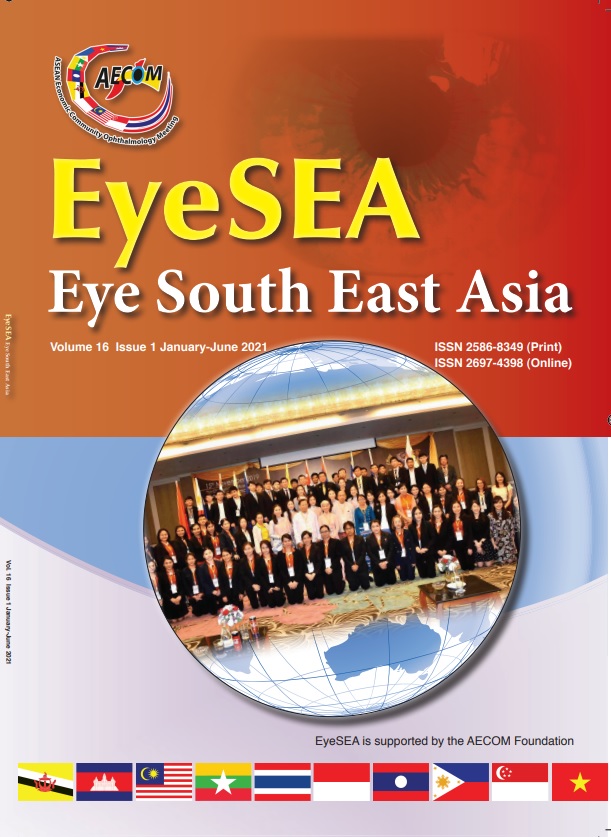Effect of switching treatment to Ranibizumab or Aflibercept for diabetic macular edema in patients refractory to Bevacizumab
Main Article Content
Abstract
Objectives: To study best corrected visual acuity (BCVA) and central subfield thickness (CST) changes after switching to ranibizumab or aflibercept in patients with diabetic macular edema who are unresponsive to treatment with Bevacizumab.
Design: Retrospective study
Methods: Patients at retina clinic, the ophthalmology department, Thammasat University Hospital in 2020 were included. The selected samples in this study were 40 diabetic macular edema patients who were unresponsive to bevacizumab treatment and switched to ranibizumab or aflibercept.
Main outcome measures: The primary endpoint outcomes were mean changes from baseline in BCVA and CST at 1 year after switching to ranibizumab or aflibercept.
Results: The forty eyes of 40 patients were included in the study, of whom 19 patients were switched to ranibizumab and 21 patients were switched to aflibercept. Post-switch, there was a statistically significant improvement in the CST in both ranibizumab and aflibercept groups. In addition, the patients who switched from bevacizumab to ranibizumab or aflibercept had improvement in BCVA but there were no statistically significant changes.
Conclusions: One-year results suggest switching to intravitreal ranibizumab and aflibercept in patients who are nonresponsive to bevacizumab are effective in improving central subfield thickness in DME patients.
Article Details
References
2. Shashank G, Parul D: Diabetic macular edema. Venu Eye Institute and Research Center. 2011; 41-45.
3. Arnall P, Thomas A. Photocoagulation for Diabetic Macular Edema: Early Treatment Diabetic Retinopathy Study Report Number 1. 1985:1796-1806.
4. Quan D, David M, Danis M: Ranibizumab for Diabetic maculae edema Result from 2 phase III Randomized Trials: RISE and RIDE. The American Academy of Ophthalmology2012, 119:789-801.
5. Brown DM, Campochiaro PA, Singh RP, Li Z, Gray S, Saroj N, Rundle AC, Rubio RG, Murahashi WY: Ranibizumab for macular edema following central retinal vein occlusion: six-month primary end point results of a phase III study. Ophthalmology 2010, 117(6):1124-1133.e1121-1124- 1133.e1121.
6. Brown DM, Kaiser PK, Michels M, Soubrane G, Heier JS, Kim RY, Sy JP, Schneider S: Ranibizumab versus verteporfin for neovascular age-related macular degeneration. The New England Journal of Medicine 2006, 355(14):1432-1444.
7. Rosenfeld PJ, Brown DM, Heier JS, Boyer DS, Kaiser PK, Chung CY, Kim RY: Ranibizumab for neovascular age-related macular degeneration. The New England Journal of Medicine 2006, 355(14):1419-1431.
8. Rosenfeld PJ, Moshfeghi AA, Puliafito CA: Optical coherence tomography findings after an intravitreal injection of bevacizumab (avastin) for neovascular age-related macular degeneration. Ophthalmic Surgery, Lasers & Imaging: The Official Journal of the International Society for Imaging in the Eye 2005, 36(4):331-335.
9. Schmucker C, Ehlken C, Agostini HT, Antes G, Ruecker G, Lelgemann M, Loke YK: A Safety Review and Meta-Analyses of Bevacizumab and Ranibizumab: Off-Label versus Gold Standard. PLoS ONE 2012, 7(8):e42701.
10. Fassnacht-Riederle H, Becker M, Graf N, Michels S. Effect of aflibercept in insufficient responders to prior anti-VEGF therapy in neovascular AMD. Graefes Arch Clin Exp Ophthalmol. 2014;252(11):1705- 1709.
11. Martin DF, Maguire MG, Ying GS, Grunwald JE, Fine SL, Jaffe GJ: Ranibizumab and bevacizumab for neovascular age-related macular degeneration. N Engl J Med 2011, 364(20):1897-1908.


